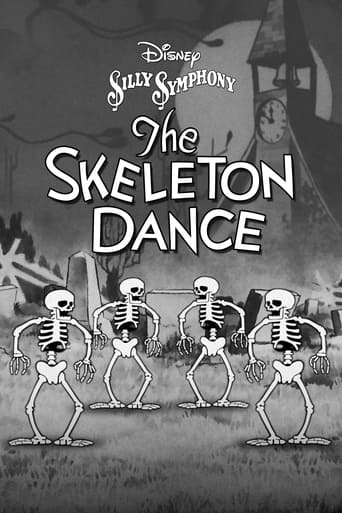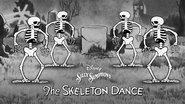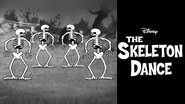OllieSuave-007
This is the first of Walt Disney's Silly Symphony cartoons, featuring four skeletons dancing throughout the night in a cemetery in delightful and characteristic fashion.The black and white animation was great and the music was very catchy and harmonic, setting the right mood for a creepy little cartoon and giving off sound effects that matches the animated action.The cartoon has just plenty of Halloween related things, from black cats to bats, from owls to creepy looking trees, and from headstones to, of course, skeletons. Fun stuff here! Grade A
José Luis Rivera Mendoza (jluis1984)
It was in 1928 when sound entered the realm of motion pictures and with it a new age arrived to the young medium and the conventions of an art form were changed forever. This new technology, that allowed movies to be able to have their own musical score independent of the theater's orchestra, entered the mind of a young film director and animator named Walt Disney, who had been producing short animated films with the help of the brilliant cartoonist Ub Iwerks. Disney decided to take advantage of the novelty of sound and create a series of short musical animations to distribute along their Mickey Mouse cartoons (which also began to be produced with sound), in which they would be able to experiment with new techniques, characters and ideas. He named the series, "Silly Symphonies", and the very first one of them, 1929's "The Skeleton Dance", would revolutionize animation forever.In "The Skeleton Dance", the action is set on an abandoned graveyard during a windy night under the full moon. It is the perfect night for the creatures of the night, and so the bats fly from the belfry, the spiders go out for a walk, and an owl watches scared the action that's about to begin: the dead rise from their graves, and they are ready to dance. A skeleton comes out first, scaring a couple of cats who were fighting, and then he calls his friends, other skeletons who are willing to play some music and celebrate. Using their bones as musical instruments, the Skeletons play a haunting tune, dance to the music, and even dance Ring Around the Rosie, having fun until the moon hides and the new day begins, because as soon as the rooster appears to announce that it's morning, the Skeletons must return to their graves, and prepare themselves for the next time.Created by Ub Iwerks and Walt Disney, "The Skeleton Dance" is, as its tag-line says, a talking picture novelty in which audiences where able to witness a good song accompanied by an animated film, pretty much similar to what we now know as a musical video. What makes the movie amazing is the way it perfectly mixes the horror atmosphere of its setting with the whimsical comedy that made Walt Disney Productions' short films so popular with the audiences. Skulls, bats, cats and spiders make an apparition in the movie, in what could be the perfect scenario for a horror film, but this time the skeletons only want to have fun. Carl W. Stalling, composer of the film's song (and another influential figure in the history of animation), creates in "The Skeleton Dance" one of the best Disney tunes ever, perfectly putting in his music that mix of horror and humor that the short film embodies.Ub Iwerks' art shines through the film, and Disney makes sure to take the most advantage of his friend's talent. As written above, they saw the "Silly Symphonies" as a way to experiment, and "The Skeleton Dance" showcases Iwerks and his team making a highly dynamic film, as well as creating pretty impressive sequences where perspective is put to great use. It's also very imaginative the many things they do with their skeletons, specially when they made them use the things found in the cemetery as musical instruments (including cats, and later, their own bones). The choreography of the Skeleton dance is very funny, and one gets the feeling that this group of young animators were truly having fun when making this little film. In many ways, "The Skeleton Dance" was way ahead of its time, and includes elements that years later would be part of the horror genre.Among Disney's early films, "The Skeleton Dance" is one of enormous importance, as thanks to its big success Disney was able to produce more cartoons of his established characters. It also produced many imitators (WB's "Merry Melodies" and MGM's "Happy Harmonies" being the best of them) and a completely new style of short animations. Sadly, the friendship between Disney and Iwerks would be broken and Iwerks abandoned Disney in 1930 to open his own studio and later to work at Columbia Pictures (where in 1937 he remade "The Skeleton Dance" in color, under the name of "Skeleton Frolics"). While he never found the same success he had with Disney, Ub Iwerks' work proved to be among the most influential in the history of animation, becoming the teacher of other masters like Chuck Jones, and even now, animators today study the magic of Ub Iwerks and his dancing skeletons.10/10





